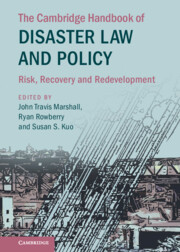Book contents
- The Cambridge Handbook of Disaster Law and Policy
- The Cambridge Handbook of Disaster Law and Policy
- Copyright page
- Dedication
- Contents
- Figures
- Maps
- Tables
- Contributors
- Foreword: Current Trends in Disaster Law and Policy
- Acknowledgments
- Introduction
- Part I Critical Perspectives on the Evolution of Disaster Law and Policy
- Part II Effective Governance as an Imperative for Responsive Disaster Law and Policy
- Part III Law’s Role in Promoting Hazard Mitigation: Intergovernmental, International, National, and Local Approaches
- 9 Local Resilience, Land Use Law, and Disaster Planning
- 10 Financing City Resilience
- 11 Disaster, Land Use, European Union Law and the Impact on EU Member States: The Relevance of the 2019 Decision of the Dutch Supreme Court Ordering Cuts in Greenhouse Gas Emissions
- 12 Covid-19 and Cooperation in Times of Disaster
- 13 Disaster Recovery in Rural Communities
- 14 Wildfire Federalism: A Framework for Local Government Participation in Disaster Planning
- 15 A Comparative Review of Hazard-Prone Housing Acquisition Laws, Policies, and Programs in the United States and Aotearoa New Zealand: Opportunities to Improve Practice
- 16 Urban Transformation as a Resilience Strategy: Earthquake Preparedness in Istanbul
- 17 How Do Green Cities Prevent Disasters?
- 18 Constructing a Resilient Energy Supply
- 19 Building a Resilient Power Grid
- 20 Weaponizing Private Property and the Chilling Effect of Regulatory Takings Jurisprudence in Combating Global Warming
- Part IV Private Sector Initiatives to Promote Disaster Resilience and Recovery
- Part V Lawyers As Disaster Law and Policy Leaders: Training for Students and Guidance for Practitioners
- Part VI Cultural Heritage Protection and Cross-Disciplinary Opportunities for Advancing Disaster Law and Policy
- Part VII Disasters and Vulnerable Communities
12 - Covid-19 and Cooperation in Times of Disaster
from Part III - Law’s Role in Promoting Hazard Mitigation: Intergovernmental, International, National, and Local Approaches
Published online by Cambridge University Press: 27 October 2022
- The Cambridge Handbook of Disaster Law and Policy
- The Cambridge Handbook of Disaster Law and Policy
- Copyright page
- Dedication
- Contents
- Figures
- Maps
- Tables
- Contributors
- Foreword: Current Trends in Disaster Law and Policy
- Acknowledgments
- Introduction
- Part I Critical Perspectives on the Evolution of Disaster Law and Policy
- Part II Effective Governance as an Imperative for Responsive Disaster Law and Policy
- Part III Law’s Role in Promoting Hazard Mitigation: Intergovernmental, International, National, and Local Approaches
- 9 Local Resilience, Land Use Law, and Disaster Planning
- 10 Financing City Resilience
- 11 Disaster, Land Use, European Union Law and the Impact on EU Member States: The Relevance of the 2019 Decision of the Dutch Supreme Court Ordering Cuts in Greenhouse Gas Emissions
- 12 Covid-19 and Cooperation in Times of Disaster
- 13 Disaster Recovery in Rural Communities
- 14 Wildfire Federalism: A Framework for Local Government Participation in Disaster Planning
- 15 A Comparative Review of Hazard-Prone Housing Acquisition Laws, Policies, and Programs in the United States and Aotearoa New Zealand: Opportunities to Improve Practice
- 16 Urban Transformation as a Resilience Strategy: Earthquake Preparedness in Istanbul
- 17 How Do Green Cities Prevent Disasters?
- 18 Constructing a Resilient Energy Supply
- 19 Building a Resilient Power Grid
- 20 Weaponizing Private Property and the Chilling Effect of Regulatory Takings Jurisprudence in Combating Global Warming
- Part IV Private Sector Initiatives to Promote Disaster Resilience and Recovery
- Part V Lawyers As Disaster Law and Policy Leaders: Training for Students and Guidance for Practitioners
- Part VI Cultural Heritage Protection and Cross-Disciplinary Opportunities for Advancing Disaster Law and Policy
- Part VII Disasters and Vulnerable Communities
Summary
The coronavirus disease (Covid-19) has made it apparent that states have different capacities to detect, effectively respond to, and manage highly infectious diseases. Concomitantly, the resources necessary to support robust health systems are distributed inequitably, which inevitably places greater stress on societies with the most vulnerable health infrastructure. In 2005, the World Health Organization (WHO) found that health capacities were nowhere near “a path to timely implementation worldwide.” By 2013, well before the current Covid-19 pandemic, studies found that no African state had fully implemented their core health capacity requirements under the International Health Regulations of 2005. Indeed, many of the countries listed in the Global Health Security Index ranked as “least prepared” are in Africa, with Somalia and Equatorial Guinea appearing at the very bottom. The lack of capacity especially visible in African countries and elsewhere in the Global South is in part due to historical vulnerability from slavery, colonialism, neocolonialism, political instability, and conflict, as well as neoliberal reform policies like structural adjustment. This chapter analyzes the international obligations of capacity-building and cooperation in light of Covid-19.
Keywords
- Type
- Chapter
- Information
- The Cambridge Handbook of Disaster Law and PolicyRisk, Recovery, and Redevelopment, pp. 221 - 228Publisher: Cambridge University PressPrint publication year: 2022
- 1
- Cited by

